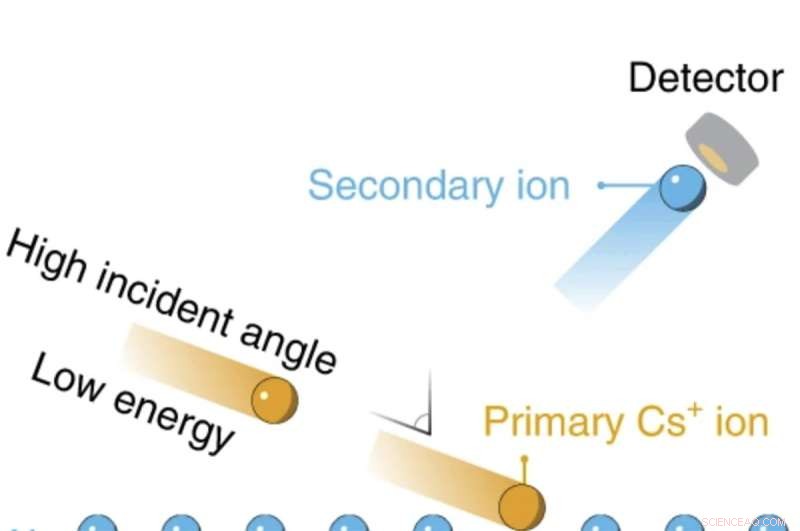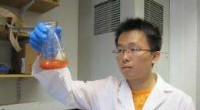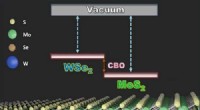
Wetenschap
Secundaire ionenmassaspectrometrie onthult atomen waaruit MXenen en hun voorlopermaterialen bestaan

Een nieuwe techniek die gebruik maakt van secundaire-ionenmassaspectrometrie heeft Drexel-onderzoekers een frisse kijk gegeven op de tweedimensionale materialen die ze al meer dan tien jaar bestuderen. Krediet:Drexel University
Sinds de eerste ontdekking van wat in 2011 een snelgroeiende familie van tweedimensionale gelaagde materialen is geworden, genaamd MXenes, hebben onderzoekers van de Drexel University gestaag vooruitgang geboekt bij het begrijpen van de complexe chemische samenstelling en structuur, evenals de fysische en elektrochemische eigenschappen, van deze uitzonderlijk veelzijdige materialen. Meer dan een decennium later hebben geavanceerde instrumenten en een nieuwe benadering het team in staat gesteld om in de atomaire lagen te kijken om het verband tussen de vorm en functie van de materialen beter te begrijpen.
In een recent gepubliceerd artikel in Nature Nanotechnology , rapporteerden onderzoekers van Drexel's College of Engineering en het Warschau Institute of Technology en Institute of Microelectronics and Photonics in Polen een nieuwe manier om te kijken naar de atomen waaruit MXenen en hun voorlopermaterialen, MAX-fasen, bestaan, met behulp van een techniek die secundaire ionenmassaspectrometrie wordt genoemd. Daarbij ontdekte de groep atomen op locaties waar ze niet werden verwacht en onvolkomenheden in de tweedimensionale materialen die enkele van hun unieke fysieke eigenschappen zouden kunnen verklaren. Ze toonden ook het bestaan aan van een geheel nieuwe onderfamilie van MXenen, oxycarbiden genaamd, tweedimensionale materialen waarin tot 30% van de koolstofatomen is vervangen door zuurstof.
Deze ontdekking zal onderzoekers in staat stellen om nieuwe MXenen en andere nanomaterialen te bouwen met afstembare eigenschappen die het meest geschikt zijn voor specifieke toepassingen van antennes voor 5G en 6G draadloze communicatie en schilden voor elektromagnetische interferentie; tot filters voor waterstofproductie, -opslag en -scheiding; tot draagbare nieren voor dialysepatiënten.
"Een beter begrip van de gedetailleerde structuur en samenstelling van tweedimensionale materialen zal ons in staat stellen hun volledige potentieel te ontsluiten", zegt Yury Gogotsi, Ph.D., Distinguished University en Bach-professor in het College, die het MXene-karakteriseringsonderzoek leidde. "We hebben nu een duidelijker beeld van waarom MXenes zich gedragen zoals ze doen en zullen hun structuur en dus gedrag kunnen aanpassen aan belangrijke nieuwe applicaties."
Secundaire-ionenmassaspectrometrie (SIMS) is een veelgebruikte techniek om vaste oppervlakken en dunne films te bestuderen en hoe hun chemie verandert met de diepte. Het werkt door een straal geladen deeltjes op een monster te schieten, die de atomen op het oppervlak van het materiaal bombardeert en uitwerpt - een proces dat sputteren wordt genoemd. De uitgestoten ionen worden gedetecteerd, verzameld en geïdentificeerd op basis van hun massa en dienen als indicatoren voor de samenstelling van het materiaal.
Hoewel SIMS in de loop der jaren is gebruikt om meerlagige materialen te bestuderen, was de diepteresolutie beperkt bij het onderzoeken van het oppervlak van een materiaal (meerdere angström). A team led by Pawel Michalowski, Ph.D., from Poland's Institute of Microelectronics and Photonics, made a number of improvements to the technique, including adjusting the angle and energy of the beam, how the ejected ions are measured; and cleaning the surface of the samples, which allowed them to sputter samples layer by layer. This allowed the researchers to view the sample with an atom-level resolution that had not been previously possible.
"The closest technique for analysis of thin layers and surfaces of MXenes is X-ray photoelectron spectroscopy, which we have been using at Drexel starting from the discovery of the first MXene," said Mark Anayee, a doctoral candidate in Gogotsi's group. "While XPS only gave us a look at the surface of the materials, SIMS lets us analyze the layers beneath the surface. It allows us to 'remove' precisely one layer of atoms at a time without disturbing the ones beneath it. This can give us a much clearer picture that would not be possible with any other laboratory technique."
As the team peeled back the upper layer of atoms, like an archaeologist carefully unearthing a new find, the researchers began to see the subtle features of the chemical scaffolding within the layers of materials, revealing the unexpected presence and positioning of atoms, and various defects and imperfections.
"We demonstrated the formation of oxygen-containing MXenes, so-called oxycarbides. This represents a new subfamily of MXenes—which is a big discovery." said Gogotsi. "Our results suggest that for every carbide MXene, there is an oxycarbide MXene, where oxygen replaces some carbon atoms in the lattice structure."
Since MAX and MXenes represent a large family of materials, the researchers further explored more complex systems that include multiple metal elements. They made several pathbreaking observations, including the intermixing of atoms in chromium-titanium carbide MXene—which were previously thought to be separated into distinct layers. And they confirmed previous findings, such as the complete separation of molybdenum atoms to outer layers and titanium atoms to the inner layer in molybdenum-titanium carbide.
All of these findings are important for developing MXenes with a finely tuned structure and improved properties, according to Gogotsi.
"We can now control not only the total elemental composition of MXenes, but also know in which atomic layers the specific elements like carbon, oxygen, or metals are located," said Gogotsi. "We know that eliminating oxygen helps to increase the environmental stability of titanium carbide MXene and increase its electronic conductivity. Now that we have a better understanding of how much additional oxygen is in the materials, we can adjust the recipe—so to speak—to produce MXenes that do not have it, and as a result more stable in the environment."
The team also plans to explore ways to separate layers of chromium and titanium, which will help it develop MXenes with attractive magnetic properties. And now that the SIMS technique has proven to be effective, Gogotsi plans to use it in future research, including his recent $3 million U.S. Department of Energy-funded effort to explore MXenes for hydrogen storage—an important step toward the development of a new sustainable energy source.
"In many ways, studying MXenes for the last decade has been mapping uncharted territory," said Gogotsi. "With this new approach, we have better guidance on where to look for new materials and applications." + Verder verkennen
Titaniumcarbidevlokken verkregen door selectief etsen van titaniumsiliciumcarbide
 Waarom zijn vlinders belangrijk?
Waarom zijn vlinders belangrijk?  Onderzoek:de helft van de cosmetica in de VS bevat giftige chemicaliën
Onderzoek:de helft van de cosmetica in de VS bevat giftige chemicaliën Droogteverzachtende sneeuw in Californië zwaarste in 22 jaar
Droogteverzachtende sneeuw in Californië zwaarste in 22 jaar Zware sneeuwstorm teistert Duitsland, upends reizen
Zware sneeuwstorm teistert Duitsland, upends reizen Voedselfraude van boer tot bord bestrijden met een mobiel traceringssysteem voor ingrediënten
Voedselfraude van boer tot bord bestrijden met een mobiel traceringssysteem voor ingrediënten
Hoofdlijnen
- Hoe een PCR-primer te ontwerpen
- Beperkingen Enzymen die worden gebruikt in DNA-vingerafdrukken
- Een eiland verkennen dat is binnengevallen door padden en kikkers
- 3D-verpakking van DNA reguleert celidentiteit
- 5 waargebeurde verhalen over een bij de geboorte gescheiden tweeling
- Twee hersengebieden werken samen om vinken te helpen weten wanneer en hoe ze hun liedjes moeten afstemmen op specifieke situaties
- Wat is een endotherme reactie?
- Grootte van witrotschimmels verklaard door de breedte van de betrokken genfamilies
- Eenvoudig epitheelweefsel: definitie, structuur en voorbeelden
- Nanobuisjes op een chip kunnen optische vermogensmetingen vereenvoudigen

- Selenium onderdrukt stafylokok op implantaatmateriaal

- Model voorspelt nauwkeurig de elektronische eigenschappen van een combinatie van 2D-halfgeleiders

- Nanovezelsteigers demonstreren nieuwe functies in het gedrag van stam- en kankercellen

- Onderzoekers creëren nieuwe microdeeltjes die zichzelf assembleren als atomen tot moleculen

 Toyota, Suzuki werkt samen in technologie voor zelfrijdende auto's
Toyota, Suzuki werkt samen in technologie voor zelfrijdende auto's Maan om meteorenshow te bederven:astronomen
Maan om meteorenshow te bederven:astronomen Studie onthult oorsprong van beweging van de oceaan in de Straat van Florida
Studie onthult oorsprong van beweging van de oceaan in de Straat van Florida Wat is verantwoordelijk voor regendruppels die op aarde vallen?
Wat is verantwoordelijk voor regendruppels die op aarde vallen?  Berekening van gemiddelde stroom
Berekening van gemiddelde stroom Nieuwe tools helpen gemeenschappen hun uitstoot lokaal te meten en te verminderen
Nieuwe tools helpen gemeenschappen hun uitstoot lokaal te meten en te verminderen Onderzoekers gebruiken fluorescerende koolstof nanobuisjes om eierstokkanker op te sporen
Onderzoekers gebruiken fluorescerende koolstof nanobuisjes om eierstokkanker op te sporen Waarom banken hun buitenlandse activa niet genoeg diversifiëren?
Waarom banken hun buitenlandse activa niet genoeg diversifiëren?
- Elektronica
- Biologie
- Zonsverduistering
- Wiskunde
- French | Italian | Spanish | Portuguese | Swedish | German | Dutch | Danish | Norway |

-
Wetenschap © https://nl.scienceaq.com

